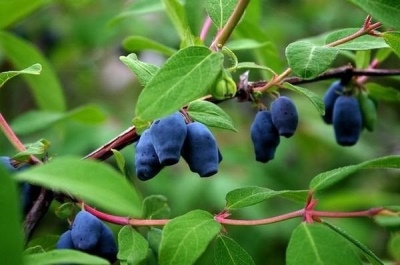
- Authors: M.N. Plekhanov, A.V. Kondrikova (Federal Research Center All-Russian Institute of Plant Genetic Resources named after N.I. Vavilov)
- Appeared when crossing: Sayanskaya 322 x Leningrad giant
- Year of approval: 2003
- Growth type: vigorous
- Description of the bush: compressed
- Escapes: thick, straight, brown-red, slightly pubescent
- Leaves: large, dark green with a bluish tinge, naked, leathery, concave, slightly folded in the middle
- Transportability: high
- Crown: oval, thick
- Flowers: with two-flowered inflorescence
The name of the honeysuckle Viola sounds pleasant and elegant. But every gardener will certainly want the bushes to produce the same high-quality crop as in the best breeding centers. And for this, objective information about the plant is required.
Breeding history
Honeysuckle Viola is a rather old variety of berry bush. It has been in the Russian State Register since 2003. An application for admission there was filed at all 9 years earlier. The developer is the Vavilov All-Russian Institute of Plant Genetic Resources. The direct curators of the project were the breeders of Plekhanova and Kondrikov.
Description of the variety
Viola bushes, which grow strongly, have a compressed appearance. Thick shoots grow straight. They have a brownish red tint and are slightly pubescent. Large dark green leaves have a bluish tint. The bare leaf blade has a pronounced leathery character. This plate is always concave. It folds slightly along the midribs. The formation of two-flowered inflorescences is characteristic. Young light green branches are relatively thin. Viola's crown is close to an oval in shape.
Fruit characteristics
On average, the mass of this variety is 1 g. They are distinguished by an elongated geometric shape. The blue-violet surface of the fruit has a light waxy bloom. Honeysuckle Viola is prized for its high vitamin content. As for the rest, its harvest has no fundamental differences from other varieties.
Taste qualities
Key Features:
sweet and sour ensemble of flavors;
light bitter note;
sugar concentration 6.8%;
the proportion of acids is 2.3%;
concentration of ascorbic acid 610 mg per 1 kg;
tasting score 3.7 points.
Ripening and fruiting
It is believed to be an early variety. The fruits ripen together, immediately after flowering. This usually occurs at the beginning of the calendar summer.
Yield
The declared ability to produce on average up to 27 centners of berries per 1 hectare. This plant is of a universal type. High transportability of the harvested crops is noted. At the age of 6-7 years, the bush is capable of producing an average of 4 kg of fruit.

Self-fertility and the need for pollinators
The variety is self-fertile. Honeysuckle is suitable as pollinators:
Amphora;
Nymph;
Moraine.
Growing and care
Viola has a decent frost resistance. Even in extreme cold, uncovered bushes feel good. The plant can grow confidently in the middle lane. At the same time, it must be remembered that it reacts poorly to a lack of moisture, and therefore needs active watering. Important: the grown crop should be harvested as soon as possible, otherwise it will fall off.
Planting maintenance is needed throughout the growing season. The very correct landing is very important. Viola is planted in September, October. If the weather is favorable, it is not forbidden to do this in the first half of November. In any case, it is necessary that 20-28 days remain before the onset of real cold weather.
Spring disembarkation is not very good. Due to early awakening, honeysuckle can then suffer from recurrent cold weather. It is best to choose areas with moderately acidic chernozems. The area that is shaded (by trees, tall bushes or buildings) is optimal for the development of Viola. In the open sun, she will feel uncomfortable.
The minimum size of the planting holes is 50x50x50 cm. Humus, wood ash and superphosphate must be laid in them. Shortening of shoots after planting is not practiced; the less the plant is injured, the better. Top dressing is best done with organics, not minerals. Every spring, 10 kg of humus and 0.5 kg of wood ash are used for 1 plant - this is usually enough to form a large number of impressive fruits.
When pruning Viola, 12-15 branches should be left on the bushes. Preparation for winter is carried out after pruning. Shelter of branches is not required, but the root area must be protected. The thickness of the mulch layer is at least 5 cm. This layer can be formed from:
fallen leaves;
straw;
fallen needles;
hay.
Plants will have to be protected from aphids, scale insects and honeysuckle mites. It is most correct to eliminate them with professional drugs, because the available means are not very effective. It is usually possible to completely suppress pests after two treatments. In a particularly cold climate, it is strongly recommended to mulch the bushes before winter with a layer of up to 10 cm.



































































